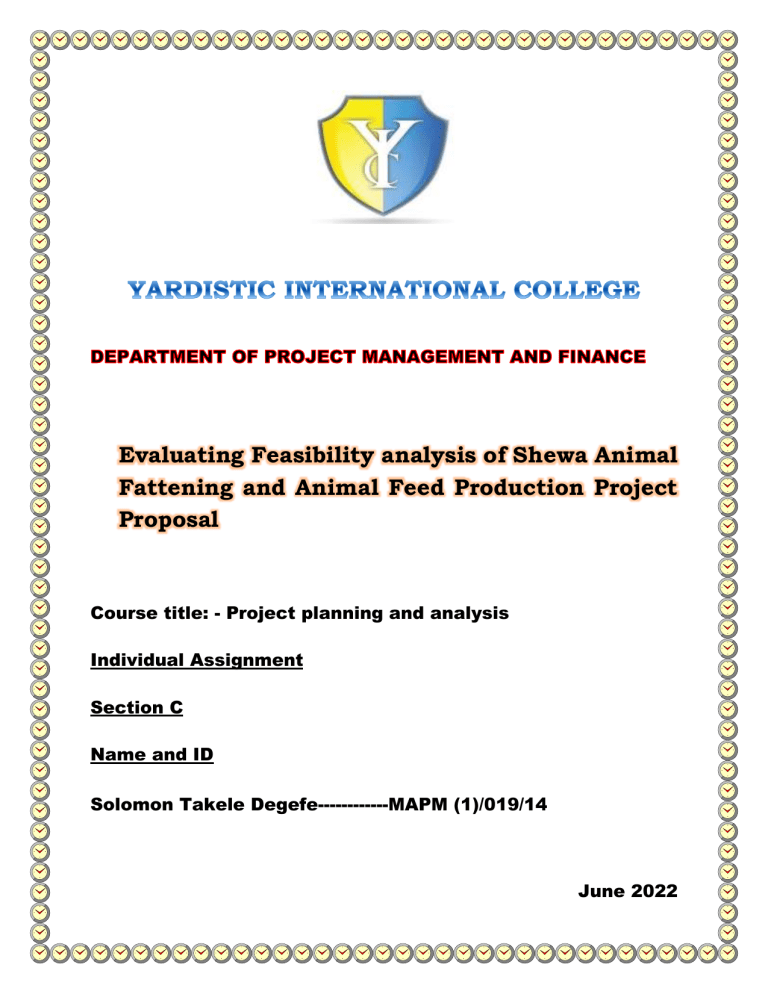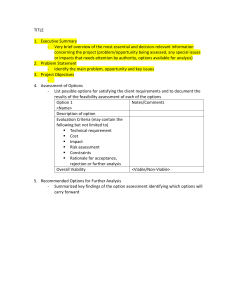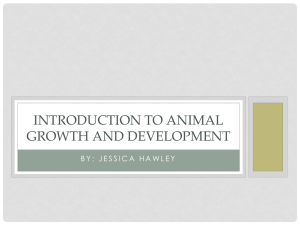
Evaluating Feasibility analysis of Shewa Animal Fattening and Animal Feed Production Project Proposal Course title: - Project planning and analysis Individual Assignment Section C Name and ID Solomon Takele Degefe------------MAPM (1)/019/14 June 2022 Table of Contents EXCUTIVE SUMMARY ........................................................................................................................... 3 Introduction .................................................................................................................................................. 4 Feasibility analysis of Shewa Animal Fattening and Animal Feed Production Project Proposal, .. 4 1. Financial analysis of the project proposal ............................................................................................... 4 1.1 The internal rate of return (IRR) ........................................................................................................ 5 1.2 Net present value ............................................................................................................................... 5 1.3 Benefit cost ratio ................................................................................................................................ 5 1.4 Discounted Payback Period ............................................................................................................... 6 2. Technical analysis the project proposal .................................................................................................. 6 3. Economic Analysis .................................................................................................................................... 7 4. Marketing Analysis ................................................................................................................................... 7 5. Socio-economic Analysis .......................................................................................................................... 7 6. Risk analysis .............................................................................................................................................. 8 Conclusion .................................................................................................................................................... 8 EXCUTIVE SUMMARY This document contains information on Evaluating Feasibility analysis of Shewa Animal Fattening and Animal Feed Production Project Proposal in terms of its technical, market, financial, economic, social, managerial, environmental, feasibility analysis. The project evaluated in terms of Financial analysis Technical analysis Marketing Analysis Socio-economic Aspect Risk analysis Under the feasibility of the project proposal, the is viable enough to implement. Accordingly, based on the projected cash flow it is estimated that the project’s initial investment will be fully recovered within 1year 9 months. The project initial investment Br. 58,993,619 payback or cover in short time .Therefore, the project is viable enough for implementation. The net present value of the project at 10% discount rate is found to be Birr 237,237,719 which is acceptable. Accordingly, the IRR of the project after tax is computed to be 61.43% indicating the viability of the project. Generally, when reviewing the project feasibility analysis it is viable enough to implement. Introduction Feasibility analysis of Shewa Animal Fattening and Animal Feed Production Project Proposal, Feasibility study is an analysis of the ability to complete project successfully, taking into account legal, economic, technological, scheduling and other factors. It allows project managers to investigate the possible negative and positive outcomes of a project before investing too much time and money. The project evaluated in terms of 1. Financial analysis 2. Technical analysis 3. Economic analysis 4. Marketing Analysis 5. Socio-economic Analysis 6. Risk analysis 1. Financial analysis of the project proposal Finance is one of the most important prerequisites to establish an enterprise. It is finance only that facilitates an entrepreneur to bring together the labor, machines and raw materials to combine them to produce goods. Under financial feasibility of the project proposal, the project list out some points it is difficult to conclude the project is viable enough to implement. Total initial investment capital Br. 58,993,619 Payback period 1year 9 months Accordingly, based on the projected cash flow it is estimated that the project’s initial investment will be fully recovered within 1year 9 months. The project initial investment Br. 58,993,619 payback or cover in short time .Therefore, the project is viable enough for implementation. 1.1 The internal rate of return (IRR) The internal rate of return (IRR) is an indicator of the efficiency or quality of an investment. A project is a good investment proposition if its IRR is greater than the rate of return that could be earned by alternate investments or putting the money in a bank account. Accordingly, the IRR of the project after tax is computed to be 61.43% indicating the viability of the project. 1.2 Net present value NPV is an indicator of how much value an investment or project adds to the capital invested. In principle a project is accepted if the NPV is non-negative. Accordingly, the net present value of the project at 10% discount rate is found to be Birr 237,237,719 which is acceptable. 1.3 Benefit cost ratio The BCR is defined as the ratio of the sum of the project’s discounted benefits to the sum of its discounted investment and operating costs. When BCR > 1, accept the project When BCR < 1, reject the project When BCR = 1, be indifferent BCR is 2 and positive this indicates this project would return 2 birr in benefits for each birr spent. 1.4 Discounted Payback Period The payback period, also called pay–off period is defined as the period required recovering the original investment outlay through the accumulated net cash flows earned by the project. Accordingly, based on the projected cash flow it is estimated that the project’s initial investment will be fully recovered within 1year 9 months. 2. Technical analysis the project proposal The technical analysis of a project idea includes: designing the various processes, installing equipment, specifying material, and Prototype testing. Technical aspects relate to the production or generation of the project output from the projects inputs. Technical analysis represents study of the project to evaluate technical and engineering aspects when a project is being examined and formulated. According to Technical Feasibility analysis of Shewa Animal Fattening and Animal Feed Production Project Proposal, The project clearly list every technical requirements with full information In terms of: Availability of inputs at reasonable cost Raw materials, oil seed cake, molasses, lime, straw or stock and salt are supplied to the Processing plant. It is available in our country abundantly. Consistency & soundness of engineering design Economics of scale in production The location of the project is better for cheap labor force and raw material, so as to decrease cost of production. Appropriate technology & alternative way of production Advantageous location of the project Maintenance & Repairs Provision for expansion Balancing of equipment: 3. Economic Analysis Economic Analysis is the process of identifying the economic benefits and costs associated with a development project. It is used to analyze and document the project net benefit with respect to the society as a whole. Include external effects in the analysis such as environmental impacts, health impacts, etc. The value of external effects is typically assigned using economic opportunity costs or shadow prices. The project proposal tells us in detail about its economic benefits to the society in general. This project will provide employment opportunity to the local population, this will raise the living standards of the people working in this project, and they also learn the latest technologies in animal feed production and fattening. 4. Marketing Analysis Regarding market access for the product of the company which is fatten livestock and animal feed were analyzed with the prevailing market situation and major players in the market. In this regard, it has planned to produce quality products with low cost to be able to penetrate the market and compete equally with competitors. The company will focus on setting up a whole seller based distribution system. 5. Socio-economic Analysis The economic impact of the project can be viewed in a number of ways. It can be viewed through its specific impact such as employment generation and increasing government revenue. The project creates employment opportunities for 328 persons. Moreover, during the life of the project it will generate Birr 89,303,459 in terms of corporate tax and also contributes to the regional income in the form of payroll tax. Beyond this specific impact, the project could have such social impacts as it will also create forward linkage with the food industry. Therefore the project is socially viable to implement. 6. Risk analysis The project proposal under risk analysis have detail information with narration and table. The project proposal tries to shows risks with percentage. Based on the risk analysis result feeding and fattening business will be risky then the management attention about price (using occasional and holiday market such like New year, Christmas, epiphany, Easter etc., those periods driving the demand and price), investment cost (avoid delay on construction phase) and operating cost (Using cost efficiency techniques), respectively. Conclusion Based on my evaluation of feasibility analysis of Shewa animal fattening and animal feed production project proposal, the project proposal is viable enough to implement. Feasibility analysis of Shewa Animal Fattening and Animal Feed Production Project Proposal in terms of its technical, market, financial, economic, social, managerial, environmental, feasibility analysis discussed in detail. Generally, the project is technically feasible, financially and commercially viable as well as socially and economically acceptable. Hence the project is worth implementing..





